Beijing Day 3
This is part 3 in a series - for the first two parts, see Beijing Day 1 and Beijing Day 2
On the third day in Beijing we went to see the Great Wall of China. Our Lonely Planet guidebook didn't have too many details about the best way to go to the wall, so we followed its suggestion to catch a bus near Tiananmen Square. In retrospect we should have done more research beforehand (more on that later).
We found a bus depot labeled "Beijing Hub of Tour Dispatch," which looked official enough. It was hard to know whether the company was run by the government or was just a private firm, but I think we would have had that problem even if we had been able to read Chinese. In China it is difficult to tell where the government ends and where private enterprise begins. In the goold ol' communist days, the state was omnipresent and ran everything. As China has opened up, that grip has loosened and private companies have sprouted up all over the place. However, many 'independent' companies are still owned and/or controlled by the central government anyway, so it can be somewhat deceiving. It turned out that this bus tour company was actually run by the government, but we weren't able to determine this until we looked it up online later.
We bought the most expensive tour ticket, which was the "Great Wall + Lunch + Ming Tombs" ticket, for 150 RMB (~$20). We were shortly herded onto the next bus with a bunch of other tourists. All of the other tourists were Chinese citizens - we were the only Westerners on the tour, which was completely in Mandarin (that probably should have set off some alarm bells, but it didn't at the time).
A side note on tourism in China - while we were there (late March), most of the attractions we visited were very crowded with tourists. The surprising part was that the vast majority of the other tourists were Chinese people, presumably visiting from the many other parts of China. I expected to see a lot of Americans and other foreign tourists, but they were actually quite rare. In retrospect it makes sense - China has 1.3 billion people, many of which probably want to visit Beijing, much like American tourists flock to Washington D.C. or Hawaii.
Anyway, the bus tour started and turned out to be a tour of Beijing for the first little while. There was a tour guide at the front of the bus pointing out landmark buildings and explaining all kinds of interesting things (we presumed) in Mandarin. We didn't understand any of it, and had to hope that we weren't missing anything important. Here's a picture of what it looked like from our perspective:
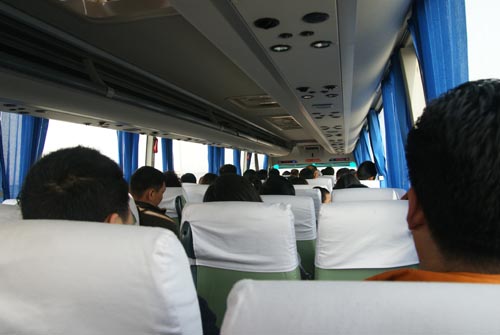
Eventually the bus stopped off somewhere and we all got off. I thought we were at the Great Wall, but we learned several minutes later that we were actually at the Ming Tombs, which are naturally the tombs of the Ming dynasty emperors. Apparently they are situated along the way to the Wall, so it is common to stop by and see them as well. They were in a hilly wooded area, which provided a nice break from the city:
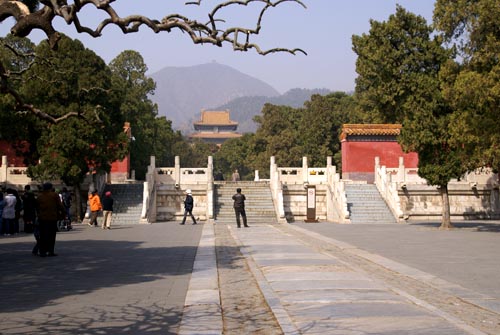
The main attraction was the underground tombs, which turned out to be a somewhat-disappointing large room with some coffins:

If we had been students of Chinese cultural history, it may actually have been quite interesting. For us, though, it probably wasn't quite worth the time taken away from visiting the Great Wall. We waited around for an hour and a half before getting back on the bus, which we almost missed due to a miscommunication about where to meet up and the fact that my watch was about 5 minutes different than the tour guide's watch.
After the tombs the bus drove us to a sort of shady-looking industrial area where we got dropped off for the "free lunch." The lunch turned out to be a forced tour through a jade museum/shop. We were told (as far as we could tell) all about how jade is a valuable, precious mineral that conveys good luck and status to its owner. Apparently there are a lot of people selling fake jade, so you should only buy the expensive authentic jade, which, as it turned out, they had a whole bunch of right there, and lots of saleswomen to sell it to you. The lunch consisted of steamed rice buns and some sort of meat. All in all it wasn't very filling, but if you wanted more food you could buy it at the overpriced shops conveniently right next door.
Eventually we finally made it back onto the bus and started off for the Great Wall at around 2:30 PM. The bus drove for a while dropped us off at the bottom of a valley below the Great Wall. I thought we'd be able to just walk up to it, but that wasn't the case. Our tour guide talked to us for a couple of minutes and then herded us into a line to buy 70 RMB tickets for a little train ride up the hill to the wall (for some reason we didn't remember reading anything about having to buy another ticket once we actually got to the wall). We had no idea what the tour guide had actually said, so we just got in line along with everybody else - it's possible that she had explained that it was possible to walk around a different way and climb up to the wall without needing to buy a train ticket, a fact we realized only after we got to the top.
Next we went to go stand in line for the train. The line looked pretty short, until we got around the first corner and noticed that it was actually quite long. We didn't think that we had any other options, so we just waited in the line, which moved incredibly slowly. After about an hour and a half, we finally got up to the ride to the top. The ride was quite a rickety contraption - it certainly didn't look like it would meet the safety standards of any first-world country. We didn't get a good picture of it, but you can sort of get the idea from these shots:
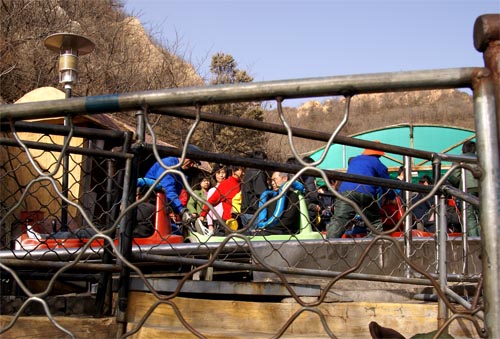

When we finally got to the top we were able to actually go onto the Great Wall. At this point we were able to see that the "real" entrance to the Wall was on the other side of the hill. That entrance had a large parking lot, bus depot, and only a slight hike to the top. Our tour had dropped us off on the back side of the hill, probably as part of some sort of arrangement with the people running the train ride. We also now had about 30 minutes left out of our "2 hours" at the wall, and we still had to get back down to the bus.
Our dropoff spot along the wall was actually a pretty good viewing point, and the wall itself was an impressive sight (though perhaps a bit less so if you were aware of the fact that the original, historical Great Wall has long since completely collapsed or been eroded away, and the current wall has been reconstructed for tourists and only runs for a couple of miles).

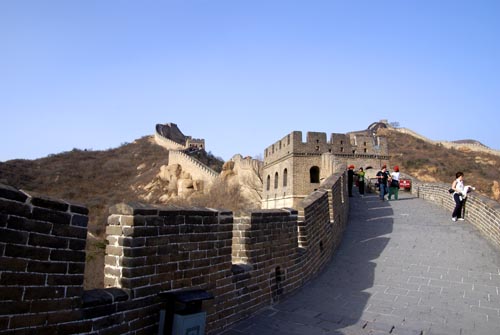
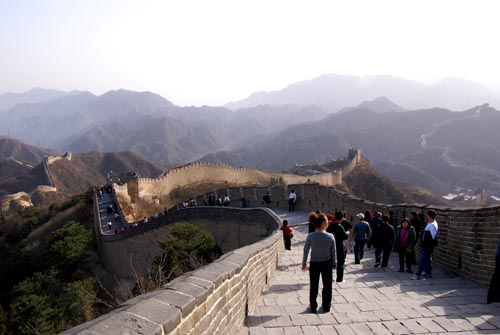
Apparently if you hike down along the wall a little way you can get away from the tourists and have a great view all to yourself. Unfortunately in our case, we only had enough time to snap a few pics before heading back to ride back down to the bus. While on the wall we found and asked a couple of Americans how they had gotten there. They said that their tour group had rented a private bus that drove to the main entrance, and that they had been there for 6 hours ("so far"). In retrospect, we clearly should have done something more like that. C'est la vie..
Anyway, the trip back to the city was fairly uneventful, though we were lucky enough to experience the joys of Beijing rush-hour traffic while trying to get back to Tiananmen Square. We were curious how the other people on our trip felt about getting ripped off, but we didn't really know how to ask them. There didn't seem to be much anger or displeasure, and certainly nobody was screaming and demanding their money back, as surely would have happened in the U.S.
Later our Chinese friend told us that we shouldn't have felt too bad about the whole thing since whole busloads of local people also went along with it - clearly we weren't suckered in because we didn't know Chinese. We also learned that we should have been tipped off by the cheap price (20 USD for a day's tour) - anything so cheap is almost guaranteed to have lots of stop offs at jade shops or herbal medicine clinics. Apparently the government set up this particular company in order to clean up the tour business, which was actually even worse beforehand.
Later that evening our friend took us to a 5-star restaurant which is apparently famous for its Peking Duck. He ordered a bunch of food for us in Chinese, so we had only a vague idea of what we were getting. Here are a couple of the appetizer dishes:

The one on the left was supposedly some sort of "pork dish." After I had a piece, it was revealed that it was actually pork hoof, which explained why it was sort of chewy.
After a while the Peking Duck arrived, roasted on a platter. Unfortunately we didn't get any pictures of it until it had already been chopped up into nice little pieces:
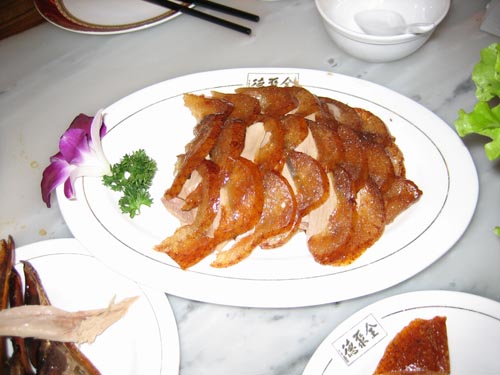
Overall it tasted pretty good. The duck even came with an ID card, which listed the duck's number and history up until the day it was killed and roasted. The meal also included the head of the duck, chopped in half:
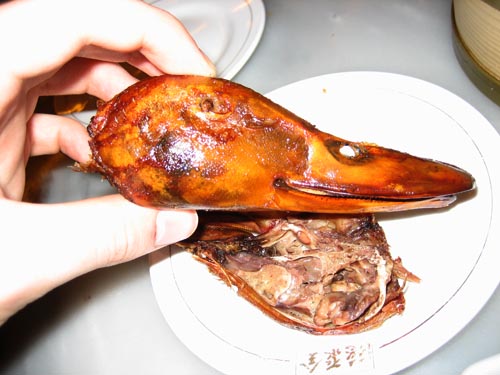
Apparently the brain of the duck is some sort of delicacy. Alas, I wasn't quite brave enough to find out how it tasted.



April 8th, 2009 - 21:23
Hey, can you send me the food pictures?
April 9th, 2009 - 05:18
I am happy to hear that you did NOT eat the duck brains! BRAINS! That is freaky. You’ve taken some really great photographs…Are you making any kind of scrapbooks from all your adventures? Even if you just put them into a “coffee-table” style book and write down the where and whens, I think you’ll be happy to have that one day!